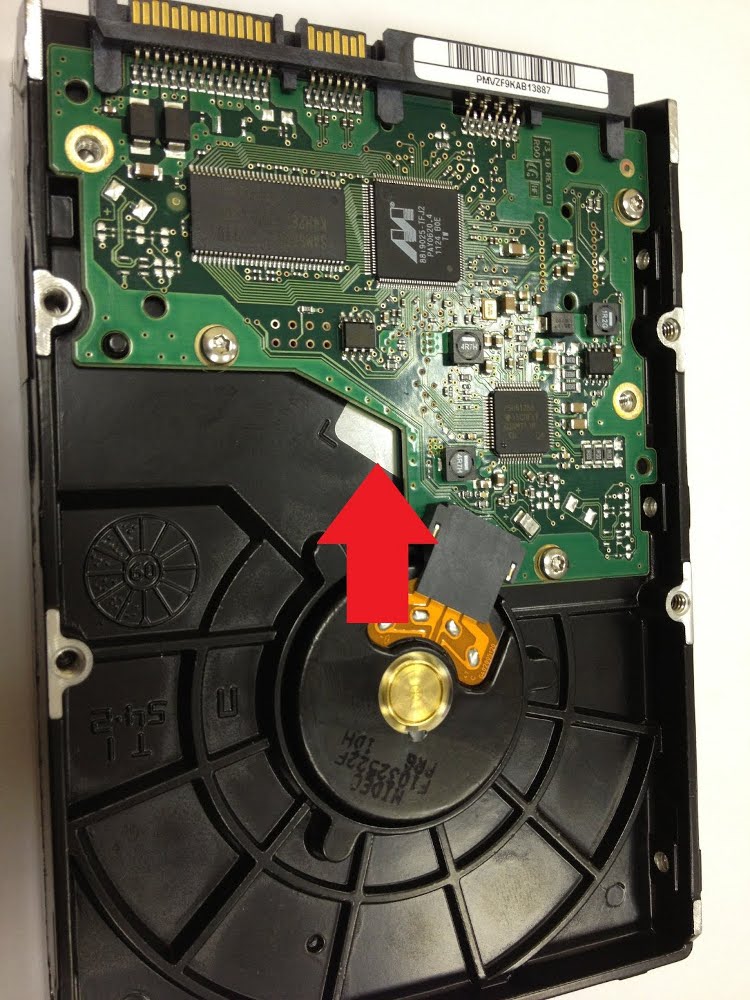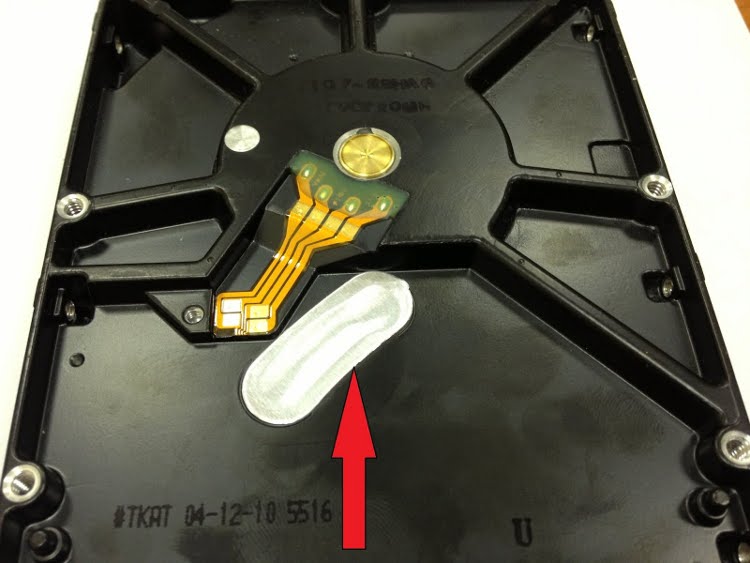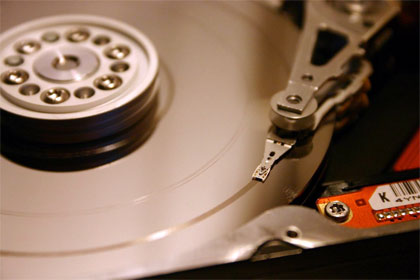Disturbing bells: when your disk is better to carry to repair

Apart from force majeure situations, problems with your disk or flash drive rarely start suddenly . As a rule, there are a number of signs - symptoms of an incipient disease. In this review we will talk about what alarm signals should be paid attention to and what they can mean.
Mechanical damage to the disc
The first thing you should pay attention to when working with a disk is its appearance, especially for portable devices. Make sure that there are no dents on the disk, deformations of the casing and cover of the HDA, cracks on the electronics board, damage to the sealed process openings (material that looks like aluminum foil) - you should especially treat them when installing or removing the disk in the system unit. One of the holes is almost completely covered by the electronics board, so it is difficult to damage it. But on the end surface it is not protected by anything:

')


If any of these defects are present, it is necessary to disconnect the disk from the computer and take it to us for analysis. In no case can you turn on such a disk, otherwise unplanned file loss is provided to you.
Extraneous sounds while running or starting a disc
The signal to danger can be three types of sounds: squeaking, grinding, clicks. During the supply of electric voltage to the disk, the engine is started, the heads are parked, the disk is initialized. In case of successful completion, the disk begins to be detected by the computer and is operating normally. Silent squeaking of a disk can emit, if the electronics board on the disk is in good condition, the motor windings are in good condition, but the spindle does not unwind the magnetic plates. This happens in most cases when the engine is stuck. It is often found on Toshiba 2.5-inch disks (spontaneously, due to the technological features of the disks and for reasons beyond the user's control) or Seagate Barracuda 7200.11 hard drives of 1-1.5 TB, as well as Hitachi of 1-2 TB , on Seagate and Hitachi it appears, in most cases, after a fall. Other HDDs can produce the same sound when sticking a block of magnetic heads on the surface of pancakes. Basically, 2.5 and 1.8 inch form factor discs are subject to this, but there are also 3.5 inch specimens with this diagnosis. The reasons may be: unsafe device removal for external drives, short-term power surges in the network or from a poor-quality power supply. The nature of this sound is the motor windings.

Scratch on the magnetic disk caused by the contact of the faulty head with the surface of the pancake.
If you hear a rattle or clicks from the disc, immediately turn it off from the computer. The rattle is caused by the contact of the read head with the surface of the magnetic disk.
The third sound is clicks. It is caused by the fact that the heads cannot be positioned. The reasons may be malfunctions of the electronics board, the magnetic heads unit. If the disc after switching on several times clicks and stops the spindle - this indicates a breakage of one or several heads. As a result of this interaction, the magnetic layer is destroyed, scratches appear on the pancakes. The disk can be damaged once and for all. Information from a disk damaged in this way is either impossible to recover or very expensive - ten times more expensive than the device itself.
During operation, the disc independently connects / disconnects.
Disks, in particular, connected via USB-interface, tend to turn off during operation. It would seem - a trifle. Automatic disconnection and connection of the disk caused by power drops, when the current is simply absent at one time, and again appears in the second.
For Flash and SSD-disks, it threatens with errors while writing a file, which causes the device to lose space and errors while reading files; here the program will receive incomplete or incorrect information.
But for HDD it threatens with major breakdowns. The disk heads will not have time to stop in the parking zone, fall onto the rotating pancake and form a scratch. As a result, file loss is ensured. Power problems can be caused by several devices:
- old power supply - weak power output of the unit or instability of voltage, as a result of electricity is not enough for all computer devices
- faulty motherboard - problem in contacts or capacitors
- hard drive is defective
- hard drive cable is damaged
Each of these devices must be checked and replaced or repaired, in the event of a malfunction.
Files are missing or arbitrarily modified
If you find that files have disappeared on your device or opening errors appear when starting them, this is a reason to worry about the state of the disk clusters. Beaten clusters (or bedy) is not such a rarity, and over time it appears on all disks. At first, it is impossible to determine whether a cluster is broken or not. When a file hits it, it may later be read incorrectly, but with the next record it’s not behaving like a bad sector and giving the information correctly when reading. But this does not mean that the cluster has been repaired on its own, then it will be more and more unstable and eventually will fail completely. Beaten clusters can be turned off, thus they will not be written to, unless these are service clusters that contain the logic of the disk. Watch your files carefully, pay special attention to opening errors and their contents. And never try to do something on your own, especially if you have never worked with them. It is impossible to repair broken clusters, and it is almost impossible to read information from such a disk at home.
The operating system cannot open the disk.

Error opening a disk with an unknown file system in the Windows operating system.
Most often, the operating system can not open the disk due to the fact that it can not recognize the disk file system and therefore can not build a hierarchy of files and folders. If file system damage is minor, then Windows will launch the Check Disk program. In another case, Windows will offer to perform fast (regardless of OS version) disk formatting. Physically, the files will remain on the disk and they can be restored with specialized software. If the formatting was successful, but after that, the OS still continues to swear at the wrong file system - read the previous paragraph about broken clusters of service areas and carry your disk to the service.
The operating system does not see the disk connection
This problem can be caused by two reasons. Firstly, the already mentioned power failure in the drive. Another option is an error or failure of the disk firmware, due to which the disk cannot turn on, start the self-diagnostics program, HDD disks do not start the engine for rotating magnetic disks and, accordingly, the device cannot perform signal reception, data read / write operations. Failure of the firmware is very often found on the Seagate disk of the new F3 architecture: 7200.11, 7200.12, ES.2, LP; Momentus 5400.6, 7200.4. On Samsung drives since 2011, because they incorporate the Seagate architecture, and on Western Digital 3.5-inch Green-series drives. At home, you can only check for power by changing the cable to connect the drive, the connection port, or connect the drive to another computer.
What if the bells rang
The main thing is not to delay. Preventing data loss is better than restoring it. Delivery and diagnostics in Storelab is free, so just call +7 (495) 776-83-89 and the courier will pick up your disk or flash drive in Moscow (including areas outside the Moscow Ring Road, except Zelenograd) for free and deliver it to us. If everything is in order with your disk, all you have to do is pick it up from our office in China Town.
Source: https://habr.com/ru/post/151892/
All Articles